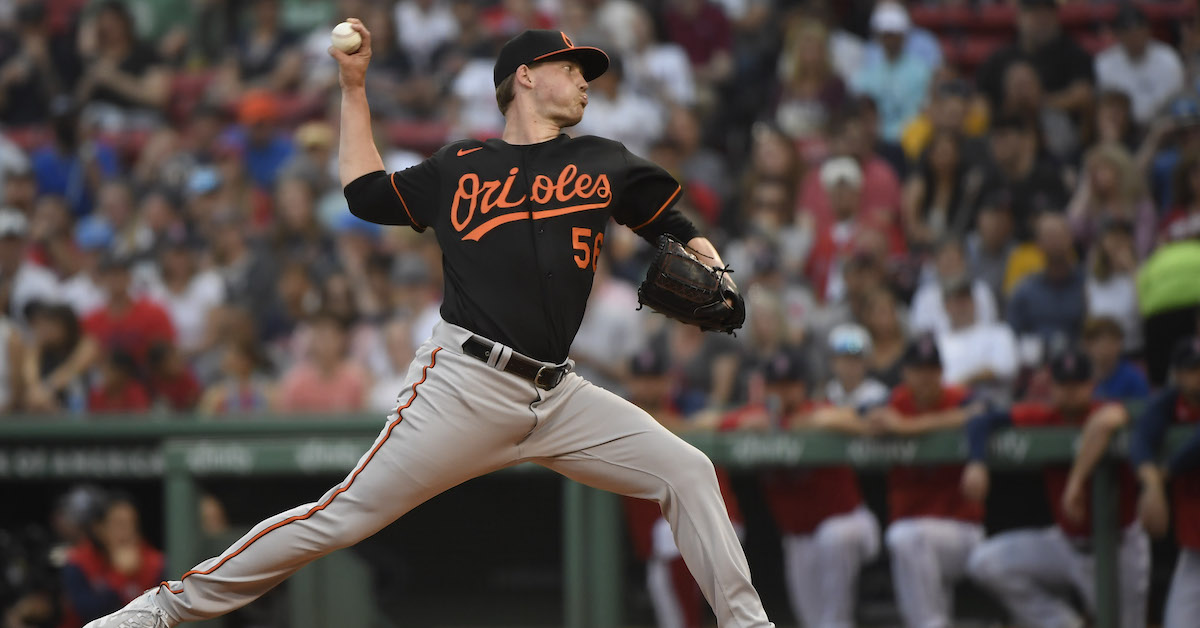Kyle Bradish Is a Young Oriole Trying To Get Outs

Kyle Bradish has a promising future in Baltimore. The 25-year-old rookie right-hander has a 6.86 ERA and a 6.06 FIP over his first 42 big league innings, but he’s also got plus stuff and improving command. Acquired from the Angels in the December 2019 Dylan Bundy deal — Los Angeles had taken him in the fourth round of the previous year’s draft out of New Mexico State University — Bradish came into the current campaign ranked seventh on our Orioles Top Prospects list.
Bradish discussed his developmental path, and the M.O. he takes with him to the mound, when Baltimore visited Fenway Park in late May.
———
David Laurila: What do you know about pitching now that you didn’t when you entered pro ball?
Kyle Bradish: “A lot of it is the analytics, which we didn’t have to the same extent when I was in college. I’m getting adjusted to that, learning about things like spin efficiency and all that stuff.”
Laurila: How much of it is impacting what you’re doing on the mound?
Bradish: “I don’t think it’s impacted me too much. I’ve always had pretty good shape and spin on my pitches, so I’d say it’s acting as more of a checkpoint. For instance, if my slider feels off one day I can go check the spin and release angles to see what they looked like.”
Laurila: The limited amount in college aside, when did you start getting access to analytic data?
Bradish: “We had some of it with the Angels, but there was more when I got over to the Orioles. That’s when we started going in-depth after bullpens, breaking down my outings. But really, I mostly just rip all my stuff through the zone. [The data] has helped with my changeup, though. It doesn’t look as good analytically, but since my fastball is basically a cutter, it plays like a true changeup.”
Laurila: Can you say more about the movement profile of your fastball?
Bradish: “I get anywhere from -2 to -7 inches of cut on it. I’ve actually tried [to learn a true cutter], but it didn’t really… I mean, my fastball is a better cutter than when I’m trying to throw an actual cutter.”
Laurila: In theory, it would be ideal for you to have both a cutter and a fastball with good spin efficiency, one that rides up in the zone.
Bradish: “I actually get pretty good ride on my fastball. The average is around 17-and-a-half [inches] and it will get up to 20. Then I have my slider, which is kind of in between a cutter and a slider.”
Laurila: Do you know if your approach angle plays a role in your fastball movement?
Bradish: “I know that low approach angle is a big thing now. I’m extremely over top, so I think that has some benefits to me having ride-cut. I would say I get pretty good extension, as well.”
Laurila: As a rule, are you attacking certain zones with specific pitches?
Bradish: “You have to adjust based on the hitter, but with my stuff — the way it moves — I generally just try to throw it over the plate and let it do its thing. But there are certain hitters where it’s, ‘All right, you have to throw away to him, because he always sits middle-in.’”
Laurila: Are there pitchers you especially enjoy watching — maybe guys you’ve been comped to, and can learn from how they’re attacking hitters?
Bradish: “I haven’t really heard many player comps, but I do like watching Clayton Kershaw. I’m from the West Coast, so I grew up watching him and the Dodgers. I’ve enjoyed watching Zack Greinke, Justin Verlander, Max Scherzer… all of those older guys. I also liked watching Tim Lincecum when he was younger. He had that big over-the-top delivery, a little more exaggerated than I am right now.”
Laurila: Have you toned down your delivery over the years?
Bradish: “I’ve definitely toned it down since college. If you look at pictures of me from back then, I used to have a lot higher glove side. It used to be pretty straight out, basically pointing straight up to the sky, which caused my back to arch, which in turn caused my head movement to waver. That’s kind of where the lack of command in college came from. I had to clean that up. Fine-tuning my mechanics is something I’ve continued to work on.”
Laurila: You have a power pitcher profile. Do you see yourself trying to add finesse to your game as you go forward?
Bradish: “I mean, finesse is always a good thing — being able to throw pitches where you want them to go, and mess with hitters’ timing. That’s something that I need to work on. But right now, I’m just focused on working my stuff through the zone.”
Laurila: Do you consider yourself a power pitcher?
Bradish: “I don’t know. All of my stuff is pretty hard — my fastball is mid-90s and gets up to 98 at times — but there are guys out there sitting 98 to 100. I think power pitchers… I mean, there are a lot of power pitchers in the big leagues right now. I’d probably just say that I’m a guy trying to get outs.”
David Laurila grew up in Michigan's Upper Peninsula and now writes about baseball from his home in Cambridge, Mass. He authored the Prospectus Q&A series at Baseball Prospectus from December 2006-May 2011 before being claimed off waivers by FanGraphs. He can be followed on Twitter @DavidLaurilaQA.